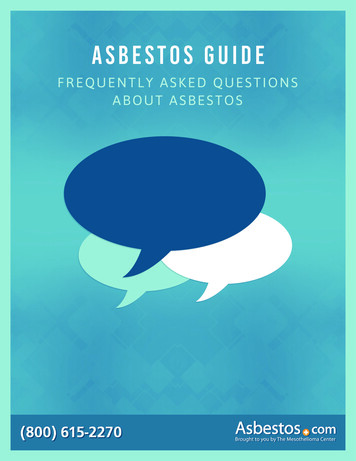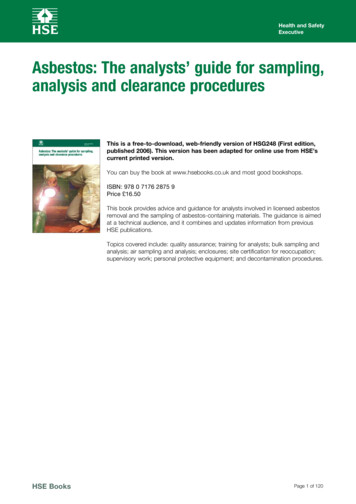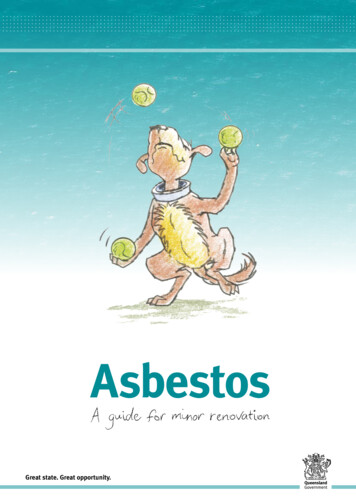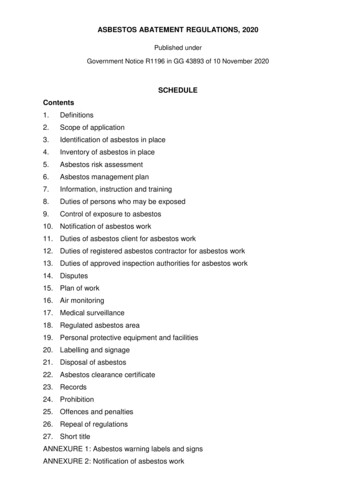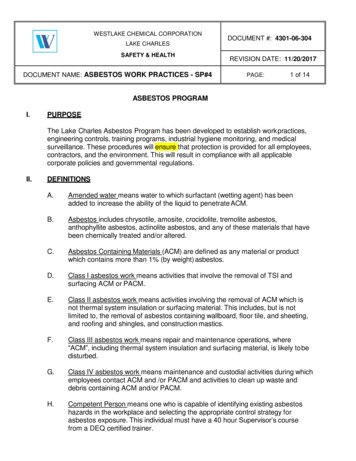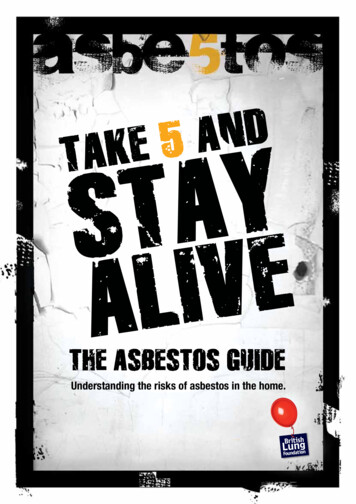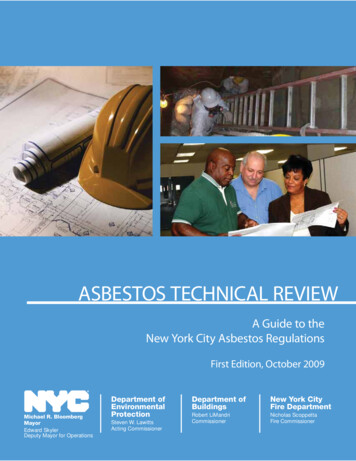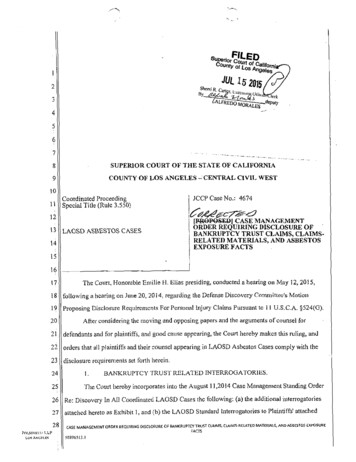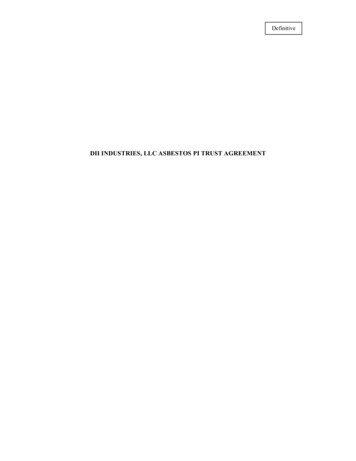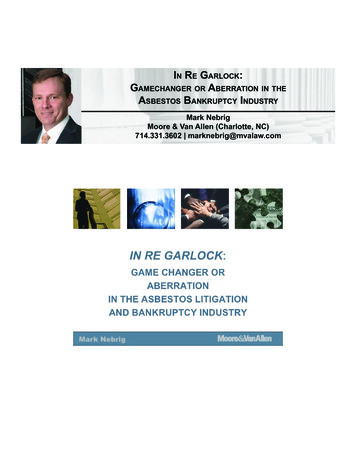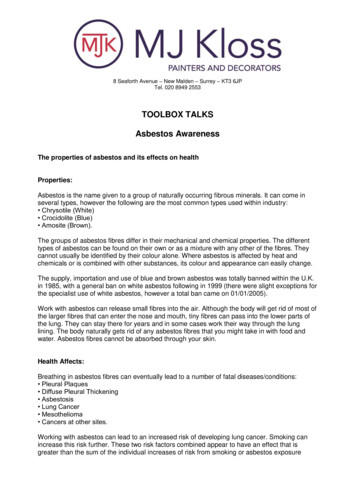
Transcription
Asbestosin ChurchesWhat you need to knowIan SimpsonUpdated November 20191
One place asbestos-containing materials can often be found in churches is in the PlantRoom. This particularly bad example is underneath a church in the north-west of England.Note the pipe lagging (which almost certainly contains asbestos) and its damaged state.First published in 2013 as “A Making It Easier Guide to Asbestos in Churches”. Updated2018. This edition updated November 2019. All photographs by Ian Simpson unless statedotherwise.Cover Photograph: All Saints Church, Shelve (Hereford Diocese).Rear Cover Photographs: St. Athanasius’ Church, Kirkdale (Liverpool Diocese) where theNational Churches Trust’s video on asbestos in churches was filmed in 2018.2
IntroductionAs a Churchwarden one of your key duties is to make sure that everyone whocarries out work in your Church – whether or not they are paid for it – does sosafely. This guide is part of a series which aims to make it easier for you to dothis.Asbestos is a natural material which was mined, refined and used in variousforms to provide insulation and fire resistance in buildings. It was used inconstruction from the mid-19th Century until its use in new buildings was phasedout from the 1970s and banned in 1999. As a result, many churches which werebuilt or modified between 1850 and 1999 contain asbestos. This booklet: explains what asbestos is, how it was used and where it might be found; tells you about your responsibilities under the Control of AsbestosRegulations 2012. corrects some of the myths surrounding asbestos;This guide is not a definitive statement of the law but is intended to give you goodgeneral guidance. We will notify you of any significant changes to the law orregulations on the website and via our diocesan email bulletin.If you are unsure have any questions or need further advice then please do nothesitate to contact the author:Ian Simpson MBA CIWFMHistoric Places of Worship Support Officer, Church of England Birmingham.ians@cofebirmingham.com3
Top TipsDo Ensure that your church has had an asbestos survey in the last fiveyears – if it hasn’t, organise one NOW. Only employ UKAS-accredited surveyors to carry out an asbestossurvey in your church. Keep the survey in a safe place – it is an important document! Make sure everyone working in your church knows where anyasbestos (or suspected asbestos) is, and what precautions theymust take around it. Treat any material which you think might contain asbestos asthough you know for certain that it does.Do not Worry! The vast majority of asbestos in buildings is safe andpresents no hazard to health. Attempt to remove asbestos yourself. Continue working if you discover suspected asbestos whilstcarrying out a job. Proceed with work to remove or remediate asbestos without firstobtaining a Faculty. Let anyone carry out work on asbestos unless you have verifiedthat they hold the appropriate License to do so.4
AsbestosWhat is Asbestos and why do I need to know about it?“Asbestos” is the common name for a family of fibrous silicate minerals whichoccur naturally in the earth’s crust. The family has at least six members, but thethree most common forms are chrysotile (“white asbestos”), amosite (“brownasbestos”) and crocidolite (“blue asbestos”). The semi-precious stone “tiger’s eye”is closely related to asbestos but completely safe.In ancient times, asbestos was considered a “miraculous” material for its fireresistant properties. The Roman writer Pliny noted however that slaves whoworked with it often became ill.More recently, asbestos was mined commercially, refined and incorporated into awide range of products for industrial use (primarily for insulation) and for use in theconstruction industry (for insulation, fire protection and as a binding agent). Muchuse was made of asbestos from 1850 onwards and its use peaked in the inter-waryears of the 20th Century.From about 1970 onwards a clear link was established showing that those whoworked in the asbestos industry were at a much higher risk of developingincurable lung disease; in 1999 its use in new buildings was banned in the UK.Many buildings built or modified between 1850 and 1999 contain asbestos. It maybe present in insulators, such as boiler pads or asbestos insulation board.Asbestos cement sheeting was a common roofing material, particularly for boilerhouses and outbuildings. Some textured surface coatings, notably Artex ,contain asbestos as do some mid-20th Century floor and ceiling tiles. Plastics usedin electrical installations prior to about 1955 often contain small amounts ofasbestos which was added to increase the insulation as well as to prevent fire.It is usually unclear to the naked eye whether or not a material containsasbestos.It is important to understand that the vast majority of asbestos-containingmaterials (ACMs) in buildings present no immediate health risks whatsoever. Theasbestos fibres are bound tightly by the plaster, cement or plastic in which theyare contained, and as long as they stay there they cannot cause any harm.5
Photo: anthophyllite, a rare form ofasbestos, viewed through an electronmicroscope. (US Geographical Survey,Public Domain)When ACMs are damaged, broken,drilled or otherwise disturbed, tinyfibres of asbestos escape into theatmosphere. Invisible to the nakedeye, under an electron microscopethe needle-like shape of the fibres isclear. These tiny needles, whenbreathed in, lodge in lung tissue andcan cause tremendous damage overtime.Asbestos fibres are particularly dangerous to people whose lungs are alreadydamaged through smoking.Tradespeople working in buildings where ACMs are present are particularlyvulnerable to exposure to asbestos fibres and the Control of Asbestos Regulationsimpose a duty on all those responsible for public buildings – including churches– to protect them by recording and marking the location of any ACMs within thebuilding.These Regulations, updated in 2012, are also intended to protect members of thepublic, building users and the environment from the effects of asbestos.Managing Asbestos – Your ResponsibilitiesIt is far more simple than you might think to comply with the law onasbestos in non-domestic buildings.The first thing you must do is find out whether your building contains asbestos. If itdoes you need to make a record of where it is, how much of it there is and whatcondition it is in.The best way of doing this is to have the building professionally surveyed by atrained, UKAS-accredited asbestos surveyor. Depending on the size of yourbuilding this Management Survey should cost between 400 and 1,000. Small6
samples of any suspected ACMs will be taken away for laboratory examination toconfirm the presence or otherwise of asbestos. If there is a suspected ACM whichcannot be sampled then the law requires that it is presumed to contain asbestos.The Management Survey Report will include an Asbestos Register detailing thesamples taken and the location, quantity and condition of any ACMs found. It willlook something like the example (from which details identifying church andsurveyor have been removed) below.The law requires you, once you have identified the ACMs, to assess the risk thatthese materials present in terms of exposing building users to airborne fibres andto prepare a written plan explaining how these risks are to be managed.A reputable surveyor will do this as part of his report, as again may be seen in theexample. A standard risk assessment calculation has been carried out based onthe type, condition and accessibility of the ACMs (in this case, they are of lowrisk), and then a summary recommendation is given for the management of therisk – a more detailed proposal for risk management appears later in the reportfrom which the example was taken.7
Note: if any part of the building is to bedemolished or refurbished you need to specify a“Demolition and Refurbishment” survey whenappointing the surveyor.Once you have the survey report, risk assessmentand plan in place, there are three furtherresponsibilities you must discharge:1. You must arrange to put the plan into action.Depending on what is suggested by your asbestossurveyor this might be as simple as affixing warninglabels (left) and arranging for access to the affectedarea to be restricted, or it may mean a substantialremoval and remediation programme (see below).2. You must monitor and review both the plan and any actions taken to implementit. The survey will tell you the condition of any ACMs as at the survey date, butover time the material could deteriorate and become “friable” which means it couldshed fibres into the atmosphere. Your surveyor will propose an appropriate reinspection interval, often annually and certainly no less often than five-yearly.3. You must inform people working in church about the asbestos. Before anyrepair or maintenance work is carried out, you must inform anybody likely todamage or disturb the ACMs of their location and condition. Giving them a copy ofthe Asbestos Register fulfils this requirement in part but it is good practice to “walkthem through” the affected areas and to get them to sign to confirm theyunderstand the precautions they must take.Note: reputable tradespeople from quality firms will have received training fromtheir employers about the dangers of asbestos and the precautions they shouldtake to avoid exposure. In particular they will know and follow this Golden Rule: if,whilst carrying out work, you discover a material that you believe containsasbestos, STOP WORK IMMEDIATELY, vacate the area and report it.8
Asbestos Remediation and RemovalThis is NOT a task for a church working party! Only Licensed Contractorsmay carry out work on higher risk ACMs. For some lower-risk materialscompetent but unlicensed contractors 1 may be used. Your surveyor willadvise you.Remediation of asbestos generally refers to a process of sealing and / orencapsulation to prevent the ACM from shedding fibres now or in the future.Removal of higher-risk ACMs is a complicated and disruptive procedure whichmay need to take place inside a sealed, pressurised enclosure in order to preventfibres from escaping into the atmosphere.If any remediation or removal work is required at your church, please rememberthe following points:1. You will need a Faculty, so contact the Diocesan Advisory Committee straightaway. Include in your Petition any “making good” of areas where, for instance,asbestos ceiling boards are being removed as the replacement material and finishwill need to be approved.2. Get a range of quotations! Asbestos work, in the author’s experience, is never“cheap” but quotations can vary considerably between contractors for the samework.3. Some high-risk work must be notified to the HSE two weeks in advance. Yourcontractor will do this, but you need to be aware of the delay when planning thework.4. Always ask to see the contractor’s license! If you don’t see the license, don’t letthem on site.1This is a change from the 2006 Regulations under which ALL asbestos work had to becarried out by a Licensed Contractor. For details on Licensing, ed-contractor.htm9
Common Myths and MisconceptionsMyth: Breathing in even one particle of asbestos means I’ll die a horribledeath.Truth: Asbestos is a natural mineral which forms part of the earth’s crust. Even ifthere were no asbestos in the built environment, the natural processes of erosionand weathering mean the chances are that every one of us has breathed inminute quantities of asbestos fibre, with no ill-effects whatsoever.Prolonged exposure to high concentrations of airborne asbestos particles does,however, significantly increase the risk of contracting certain diseases of thelungs, particularly in smokers. It is to prevent this sort of exposure that the rulesgoverning the management of asbestos in buildings were introduced.Myth: White asbestos is OK – it’s only blue asbestos that we need to worryabout.Truth: There are three main types of asbestos, commonly known as white, brownand blue asbestos. Their official names are chrysotile, amosite and crocidolite.White asbestos (chrysotile) has a different crystal structure from the other twotypes, meaning it doesn’t shed fibres quite so readily. However once those fibresare airborne, they present exactly the same risks to health. ALL forms of asbestosare covered by the Regulations and need to be managed in the mannerprescribed.Myth: We’ve got asbestos in the building – that means we must have itremoved at huge expense.Truth: Not necessarily. Provided that the asbestos-containing material (ACM) isundamaged and stable – in other words it is not shedding fibres or likely to bedamaged so that it starts to shed fibres – then it may be left in place subject toongoing monitoring of its condition.It will need to be identified, marked and possibly sealed to prevent it being drilled,broken or removed. Your asbestos surveyor will provide you with an asbestosregister which will clearly show the location of any ACM within your building andthe measures proposed for managing it.Myth: Our church wasn’t built until 2003 – that means there can’t possiblybe any asbestos in it!10
Truth: You can’t just assume this to be the case. No asbestos should have beenused in the construction of a post-1999 building but if it incorporates part of anearlier building, or items which pre-date the building (e.g. from an earlier church)then, to be on the safe side, anything which could potentially contain asbestosshould be checked.Myth: There is no need to use a UKAS-accredited asbestos surveyor, theycharge more for the same job!Truth: Anyone at all, even someone with no training or qualifications, can setthemselves up as an “asbestos surveyor” but only UKAS-accredited surveyors areaccountable for the standard of their work. Obviously there are costs involved inmaintaining the standards of training, equipment calibration and the like whichcome with accreditation but it is not fair to say they do the same job.A non-accredited surveyor “missed” no less than 116m² of asbestos insulationboard in one Liverpool church; unfortunately it was then discovered by anelectrician who was cutting out a cable run during the 2012-3 rewiring. It cost thechurch over 7,000 to make safe, not to mention a six-week delay to the job.For More Information The Health & Safety Executive’s Asbestos pages start athttp://www.hse.gov.uk/asbestos/index.htmThe National Churches Trust’s free MaintenanceBooker resource has informationabout asbestos - see the video “Tackling Asbestos in Kirkdale” es/video-andphotographs.11
12
Note the pipe lagging (which almost certainly contains asbestos) and its damaged state. . such as boiler pads or asbestos insulation board. Asbestos cement sheeting was a common roofing material, particularly for boiler . You must inform people working in church about the asbestos. Before any repair or maintenance work is carried out, you .
